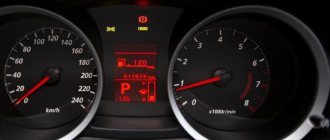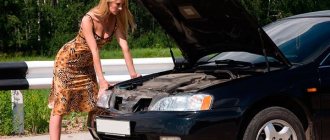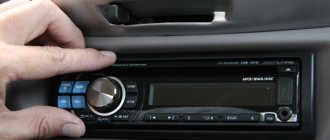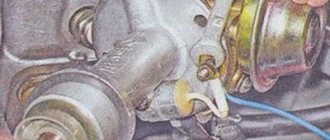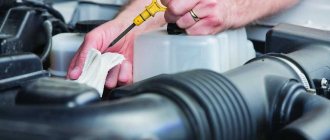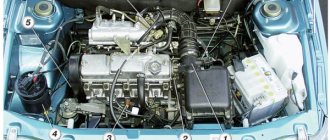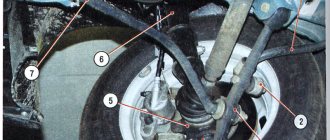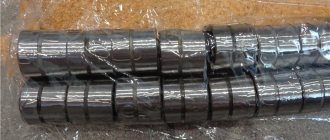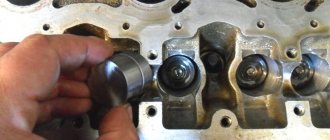Many car breakdowns are associated with a sudden stop of the engine. In some cases, the internal combustion engine stalls at idle or while driving, in others the unit constantly operates unstable and may stop working in certain modes.
Let us immediately note that this phenomenon occurs frequently, but is not always associated with serious malfunctions. For this reason, every car owner should know why the engine stalls when driving.
Fuel quality
One of the reasons is low quality gasoline, which does not meet the octane requirements for the car. The driver needs to remember where and what kind of gasoline the vehicle was last filled with. If it is indicated that the motor should run on AI-95 or AI-98, pouring AI-92 into the tank is dangerous.
The problem is caused by fuel - when you press the gas pedal fully, the speed does not pick up, and when the clutch is depressed, the power unit stalls. The situation is explained by the weak spark produced by poor fuel.
To fix the problem you need to:
- Drain fuel.
- Wash the motor.
- Clean all fuel system pipes.
- Change the fuel filter.
Car engines are sensitive to fuel quality.
Injection engines
If a car with an injection engine stalls while driving, then there may be several problems of this kind:
- The oxygen enrichment system for the fuel mixture is faulty.
- Broken oxygen sensor.
- The intake manifold is malfunctioning.
- Fuel injectors are partially or completely dirty.
- The cooling system of the unit is broken.
If the owner himself is not sure of the cause of the breakdown, the same diagnostics are needed, after which repairs are already carried out. You can describe some of the reasons in more detail, but do not forget that there can be a lot of them, and they are all different - it depends on the make of the car, the country of origin, the type of engine, etc.
Spark plug
The car stalls while driving due to spark plugs: clogged contacts, plaque formation, incorrect voltage supply.
If a black coating appears on the spark plugs, a normal spark will not be able to form. The presence of dirt on the contacts indicates low quality fuel. The contamination is caused by a defect in the oil supply system.
A black coating appears on the candles
Oil on the spark plugs is a sign of failure. The car must be sent for diagnostics. Ignoring a problem can lead to costly repairs.
Attention! When the spark plugs fail, the engine runs unevenly, the car jerks when driving, periodically stalls, and is difficult to start. If there is a red-brown coating on the contacts, low-quality fuel is poured into the tank. In this case, the spark plugs need to be replaced.
Faulty carburetor
Before you start looking for the cause in this device, it is worth checking the operation of the ignition system: if it is working, make sure there is a fuel supply (see above). Only then should you remove the carburetor cover. There are many reasons for failure, first check the presence of gasoline in the float chamber, the serviceability of the needle valve, then you can check the clogging of the jets and the operation of the accelerator pump. It is advisable to do all this not in “field conditions”, so as not to introduce dirt into the device.
Do not clean carburetor jets with metal objects: this may increase their diameter, which will lead to improper operation of the carburetor.
Throttle valve
The cause of the breakdown is contamination of the throttle valve. The car's response to the gas pedal is late, the speed is uneven, the engine stalls, the part needs to be washed. Necessary:
- Buy a special product at a car store.
- Remove the damper.
- Rinse thoroughly.
- Install back.
If these steps do not help, the problem is related to the power supply (see below).
On foreign-made cars, the throttle damper could fail. Then, when you release the gas, the engine will stall. The part is responsible for returning the damper to its normal position, eliminating dips.
To check the damper you need:
- Warm up the engine to operating temperature.
- Open the valve yourself.
- Let go quickly.
The part should return almost to the limit, pause and not reach the end so quickly. If no deceleration is observed, the damper is faulty. It needs to be replaced, repair is impossible.
Throttle valve dirty.
Recommendations
So, the car stalled while driving, what to do next:
- Using the inertia of movement, push the car off the roadway, no matter whether it is a city road or a highway.
- Turn on the alarm.
- It is mandatory to install an emergency sign at the back of the car: there are plenty of fans of high-speed driving everywhere, there is no need to create an emergency situation.
- Put the car on the handbrake.
Option 2 for further developments:
- Do the repairs yourself.
- Find a way to transport the car to the service.
In order to avoid such unpleasant and unexpected moments when the car stalls while driving, you need to follow simple rules:
- Carry out vehicle diagnostics at a service center as often as possible.
- Carry out preventive maintenance and inspection of the machine yourself.
- Monitor the condition of parts and replace them in a timely manner so that the machine does not break down in unexpected places.
You should always have a tool with you to repair minor damage, as well as a can of gasoline to avoid stopping due to its absence.
As a rule, the true cause of the breakdown is revealed quite simply. And even a car owner who does not have deep knowledge of vehicle repair can easily correct problems that arise that are accompanied by incorrect behavior of his car.
Idle speed control
On VAZ models with an engine of 8 or 16 valves and on foreign cars, the power unit starts up, then stalls due to IAC. The wrong name is idle speed sensor, the correct name is regulator.
The device monitors engine speed and maintains it. At idle, the engine stops working, or uneven speed is observed - the part is faulty. When the gearbox is switched to neutral, the engine stalls - it is worth changing the regulator.
Sometimes similar symptoms are observed when the throttle valve is dirty. It is recommended to clean it first.
Mistakes while driving
It is impossible not to mention that the engine may stall if you do not release the clutch pedal smoothly enough when changing gears in a car with a manual transmission.
This situation especially occurs at the beginning of the movement for inexperienced drivers. At the same time, problems with the gearbox or clutch may well confuse an experienced driver. The wrong gear selected when the load on the internal combustion engine is high or the speed is low, as well as untimely gear shifting will also cause the engine to stall. Such situations are typical for inexperienced motorists.
Air filter
Replacing filters in a car is an important maintenance procedure that many people forget about. As a result, the filter becomes clogged and the operation of the power unit and systems is disrupted. If there is severe contamination or damage, the engine will run unevenly and jerkily—it will stall when you press or release the gas pedal.
Attention! The engine stalls in the same way if the XX regulator fails.
To verify the malfunction, you need to dismantle the filter and inspect for damage. If dirty or worn, replacement is necessary.
Clogged air filter
Broken timing belt
This malfunction can be determined if you remove the special casing (in some cars it is enough to bend it a little). Replacing a belt takes a little time (20-30 minutes) for an experienced car owner. However, the situation is worse if, at the moment the engine stopped, a blow was heard from its side. This indicates a “meeting” of valves and piston heads, when the latter do not have special grooves that prevent collision. It’s worth finding out in advance whether you really have a car with such pistons: if so, pay special attention to the condition of the belt, otherwise you may face a major repair.
Fuel filter
A dirty fuel filter is another reason why your car stalls when driving. The part is installed on all vehicles. The problem with the device occurs among owners of used cars. The filter is forgotten and rarely changed.
Over time, the dirt fills up, it is difficult for gasoline to pass into the ramp, and there is no combustion chamber. Fuel will arrive intermittently, and then may not arrive. If the filter is clogged, the car stalls when you press the gas pedal.
You need to dismantle the fuel pump, remove the filter and install a new one. There is no point in cleaning it - the cost of the part is small.
Exhaust system and crankcase ventilation
Once upon a time, young people amused themselves by plugging the exhaust pipe of a car whose owner did not please them in some way. Today they don’t do this, but who knows?! Therefore, if the car was parked on the street and worked fine yesterday, but today it won’t start, you should take a look at the exhaust pipe. If the car starts up, but then begins to “choke”, and more and more every day, the problem may be a clogged muffler or (which happens more often) the catalyst, if there is one. In winter, the system can be clogged with frozen water - ice.
As for crankcase ventilation, the “culprit” here is a contaminated oil trap, due to which the engine begins to “suffocate” with crankcase gases and stall. The problem can be solved by washing the ventilation filter.
Fuel pump
Due to a faulty fuel pump, the car may operate normally for a while, then stall. Interruptions begin in the mechanism, fuel does not enter the chambers or arrives in small quantities. Initially, the engine will run at idle, as the speed increases, it will stall, and when the pump finally fails, it will not start.
The fuel pump is easy to repair, but the breakdown may recur, so it is better to replace it. This unit is located under the rear seat.
In summer, the fuel pump may operate intermittently due to fuel boiling. This happens on classic Soviet cars. To get rid of the problem, you have to turn off the engine and wait until the fuel cools down.
Conclusion
Here you have found some of the most common causes of engine stalling. So pay attention to the clues your motor gives you. Be sure to do a visual inspection of any suspicious component or components and troubleshoot before making a final decision. And don’t forget to analyze your car’s on-board computer. The vehicle repair manual for your specific make and model should be very helpful here.
How do you like the article?
Electrical problems
The car engine stops running while driving due to electrical problems. Initially, you need to check all the masses.
The battery terminals may not be secure enough; if the connection is poor, no power will be supplied; this is a rare problem.
You need to check the generator connections. After repairs, the repairman may forget to tighten the terminals, and the device will not charge. The battery will be completely discharged and the engine will stall while driving. The location of the generator for the VAZ-2115, 2110 and 2112 models is similar.
The generator could fail or the belt could break. This is indicated by an icon on the dashboard. It is recommended to visit a car service; repairing it yourself can be harmful.
You should check the ground that goes from the negative of the automatic transmission to the engine. For prevention, the terminals are cleaned and lubricated with a special compound.
The reason is faulty high-voltage wires. Can't be repaired - needs to be replaced.
Faulty ignition coil
When the ignition coil is not functioning, the engine periodically stalls. There is increased fuel consumption, a drop in vehicle power, and poor engine starting.
The power unit begins to “triple”, especially in the rain, the speed is uneven. A breakdown is indicated by an indicator on the dashboard.
To verify that the coil is faulty, you must:
- When “triple” occurs, remove one coil at a time. If you remove the good one, the speed will begin to “float” more; eliminating the faulty one will not change anything.
- If the part does not function, the spark plug will be wet, with a black coating, and the resistance will differ.
Attention! VAZ cars with an 8-valve engine have an ignition module, the role of which is similar to that of coils.
Vacuum brake booster
The power unit stops working when you press the brake - the problem is in the vacuum booster. The device is connected by a hose to the intake manifold.
A faulty membrane cannot create a vacuum at the right moment when you press the brake pedal. Air flows enter the working mixture, which becomes lean. The engine cannot run on such a mixture, so it stalls.
To fix the problem, it is enough to change the gaskets and membrane, and sometimes the hose.
Faulty air duct corrugation
On cars with an injector engine, the cause of the problem may be a depressurized (usually torn) air duct corrugation. Air flows past the mass air flow sensor, incorrect information is sent to the control unit, the mixture changes, and the engine stops working.
The engine “troits” even at idle. To eliminate the breakdown, it is enough to change the corrugation.
Lambda probe
The sensor is necessary to analyze the oxygen content in the exhaust gases and check the quality of the mixture. Failure of the device is the reason for poor engine starting, interruption of operation and reduction in power. Fuel consumption also increases. You can verify that the problem is related to the device by performing diagnostics.
Faulty Lambda probe
Sensors
Cars have many sensors. If one breaks down, the vehicle begins to act up, the engine may “trouble.”
Often the engine stops working due to the crankshaft timing sensor. If the part fails completely, the car will not start. Due to problems in the device, the power unit will operate unevenly and periodically stall.
The sensor may overheat.
Illiterate firmware
Car owners often have their vehicles flashed. This procedure allows you to unlock the potential of the engine and improve dynamics.
In order to save money, car enthusiasts make the firmware cheaper. As a result, the car goes further faster and stalls when the speed drops. The control unit confuses the readings and supplies the working mixture in different ways.
It's worth resetting to factory settings. When flashing, you need to choose a good specialist with extensive experience - incorrect settings can cause great harm.
A few more possible reasons why a car may stall while driving
Remember that a car consists of many interconnected mechanisms and components, and a car can stall while driving not only due to problems in the engine, but also due to other vehicle systems.
Here is a list of equally common faults that can cause the engine to stop:
- Engine overheating;
- The coolant temperature sensor or crankshaft position sensor is faulty;
- The fuse has blown;
- Oil or antifreeze has leaked;
- Problems with the throttle valve;
- Clogged spark plugs;
- The fuel or air filter is clogged;
And even this is not the entire list of problems. If your car stalls while driving and won't start, a possible reason could be that you simply ran out of gas. Yes, you can get into such a situation if you don’t refuel on time.
